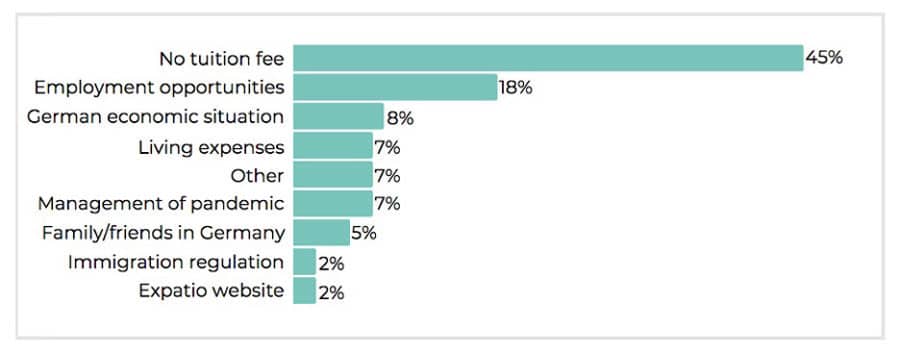Germany’s foreign enrolment reaches record high with increase of 8% in 2021/22
- There are now about 350,000 international students in German higher education institutions
- Increasing numbers of Indian students are helping to drive this recent growth
- All students studying in Germany will receive a €200 payment soon to help them weather higher energy bills prompted by Russia’s invasion of Ukraine and high inflation
The number of international students enrolled in German higher education institutions grew by 8% to reach approximately 350,000 students in the 2021/22 academic year, according to the German Academic Exchange Service (DAAD). This is a new record for foreign enrolment in Germany and the second consecutive year of growth after a 1.5% year-over-year gain in 2020/21.
This puts Germany among the top five leading study abroad destinations globally. Germany has become an increasingly popular study abroad destination thanks to an attractive combination of quality education and free tuition for non-EU students pursuing bachelor’s and master’s degrees at most public institutions. The growing number of English-taught degrees now available – around 3,400 – is also a draw.

Free tuition in most, but not all, of Germany
Every state in Germany has the power to decide whether it will allow universities to charge tuition to international students. For the most part, the benefits of attracting international student talent to Germany has outweighed any movement towards introducing tuition fees.
However, since 2017, the state of Baden-Württemberg has been charging €3,000 per year to international students. Perhaps not coincidentally, a study has shown that the number of foreign students in the state declined by 36% between 2016 and 2021.
Still, this past summer, the state government of Bavaria decided to follow the example of Baden-Württemberg and drafter a Higher Education Innovation Act that included the introduction of fees for non-EU students. This Is expected to be approved in parliament and come into effect in January 2023.
Indian students are driving growth
Like other major destinations, Germany is experiencing an influx of Indian students, and this is driving most of the overall growth in international enrolments. China remains the top sender of students (40,000) but Chinese commencements fell by 5% in 2021/22 (similar to the trend in the UK). By contrast, the number of first-year Indian students increased by 33% in 2021/22 and there were 34,000 Indian enrolments in total in 2021/22.
Otherwise, Syria, Austria, and Turkey round out the top five sending markets for German universities.
“Stay rate” is high in Germany
Germany is facing acute skills shortages in its labour market, and international students who remain in the country after graduating to work are – as is the case in many advanced economies today – ever-more crucial to the country’s continued economic competitiveness.
According to the OECD, the “stay rate” of international students in Germany (i.e., those who remain in the country to work/immigrate after their studies) is similar to that in Canada and one of the highest in the OECD. Germany’s Federal Statistics office reports that after ten years of living in Germany, 28% of former international students go on to immigrate – rising to 50% of Cameroonian students, 34% of Brazilian students, and 32% of Indian students.
A study has found that improving language supports for international students could help to further increase the stay rate.
Challenges ahead
The German economy is expected to slide into a recession early next year due in part to the knock-on effects of Germany attempting to reduce its reliance on Russian gas. Before the war, more than half of Germany’s gas was imported from Ukraine.
The energy crisis is driving higher bills for heating, electricity, and most other goods and services for Germans and international students alike. In September 2022, Germany’s inflation rate was 10% – the highest since German reunification in 1990, and poverty rates among students were high even before the crisis.
Some relief is on its way: the government has committed to providing all students, international and domestic alike, a one-time-only payment of €200 (USD$200) to help to cover cost-of-living increases. The timing of the payment is yet unclear. The government has also just announced that it will pay all December 2022 gas bills for consumers and businesses ahead of a subsidy scheme planned for Spring 2023.
Some argue that the €200 payment to student does not go far enough. Matthias Anbuhl, secretary general of the German National Association for Student Affairs (DSW), told University World News:
“Having just emerged from the COVID-19 pandemic, students are already scraping the barrel, both financially and mentally. With prices skyrocketing, they often don’t know how they are going to pay the gas and electricity bills and cover food costs in the winter.”
Higher drop-out rates can be expected if students can’t cover their accommodation or food. As Rachel Schüssler of the Free Association of Students, which represents nearly one-third of all those studying in Germany, said to DW.com:
“You actually only work in order to be able to study. Because of work, however, you don't get to study anymore. Students also decide to drop out because of rising prices. To maybe not just look for a part-time job, but then rather to just work 40 hours a week from the get-go."
Affordability an issue for international students everywhere right now
International students will find the cost of living higher not only in Germany, but also in most destinations this winter, as a global recession seems likely.
In Australia and Canada, caps have been temporarily removed on the number of hours international students can work off-campus while classes are in session. While these policies are designed to help fill acute skills shortages in the Australian and Canadian economies, some student advocates say they should be made permanent to relieve international students’ growing financial stress.
Agents responding to our latest ICEF Agent Voice survey said that students are prioritising affordability above all else this year when deciding where to study abroad. Three-quarters of agents said that “cost of study and living” is the most important factor for students, above even work and immigration opportunities.
For additional background, please see:
















